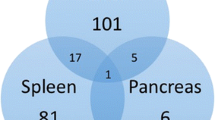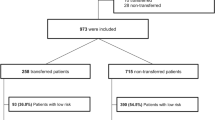Abstract
Introduction
The traditional 24-h call model faces pressure from competing needs between emergency and elective services. Recognizing this, a dedicated ESAT service was developed in Khoo Teck Puat Hospital in Singapore, with improved clinical outcomes. It was initially led by a single consultant (SC) in 2014, and subsequently evolved to a weekly consultant rotation (WC) roster in 2017 to achieve sustainability.
Methods
Each consultant led the ESAT WC service for a week and maintained ownership of their patients thereafter. All emergency surgical admissions between two distinct 6-month periods were reviewed, from May to October 2014 (pre-ESAT) and January to June 2017 (ESAT WC). Patient demographics, diagnoses, and operations were compared. Efficiency and clinical outcomes were evaluated.
Results
There were 1248 and 1284 patients in the pre-ESAT and ESAT WC group, respectively. Majority were males and in their 50s. Acute appendicitis, gallstone conditions, and soft-tissue infections made up half of the admissions. Trauma workload was comparable (7.8% pre-ESAT vs 9.5% ESAT WC). Cholecystectomies doubled during the ESAT period, 14.2% vs 7.2%, (p = 0.01). More consultants were involved in major cases (95.9% vs 86%), (p = 0.01) and more operations were performed during the day (52.1% vs 47.9%), (p = 0.01). Average time to OT was shorter and there were less major surgical complications (p = 0.02). Mortality (p = 0.08) and length of stay were reduced (4 vs 4.5 days), (p = 0.01).
Conclusion
The ESAT WC service has sustained improved outcomes in our institution.


Similar content being viewed by others
References
Pearce L, Smith SR, Parkin E, Hall C, Kennedy J, Macdonald A. Emergency general surgery: evolution of a subspecialty by stealth. World J Emerg Surg WJES. 2016;11:2. https://doi.org/10.1186/s13017-015-0058-x.
The American Association for the Surgery of Trauma. http://www.aast.org/AcuteCareSurgery.aspx. Accessed 29 Apr 2018.
Ball CG, MacLean AR, Dixon E, Quan ML, Nicholson L, Kirkpatrick AW, Sutherland FR. Acute care surgery: the impact of an acute care surgeryservice on assessment, flow, and disposition in the emergency department. Am J Surg. 2012;203(5):578–83.
Cubas RF, Gomez NR, Rodriguez S, Wanis M, Sivanandam A. GarberoglioCA. Outcomes in the management of appendicitis and cholecystitis in the setting of a new acute care surgery service model: impact on timing and cost. J Am Coll Surg. 2012;215(5):715–21.
Barnes SL, Cooper CJ, Coughenour JP, MacIntyre AD, Kessel JW. Impact of acute care surgery to departmental productivity. J Trauma. 2011;71(4):1027–32 (discussion 1033–4).
Britt RC, Weirete LJ, Britt LD. Initial implementation of an acute care surgery model: implications for timeliness of care. J Am Coll Surg. 2009;209:421–4.
Quintin KM. An audit of the workload of an Acute Care Surgery Unit in a Tertiary Academic Hospital before and after the closure of a referring Community Hospital. Cape Town: University of Cape Town; 2015.
Committee to Develop the Reorganized Specialty of Trauma. Surgical critical care, and emergency surgery: acute care surgery: trauma, critical care, and emergency surgery. J Trauma. 2005;58:614–6.
Mathur S, Goo TT, Tan TJ, Tan KY, Mak KSW. Changing models of care for emergency surgical and trauma patients in Singapore. Singap Med J. 2016;57(6):282–6. https://doi.org/10.11622/smedj.2016101.
Mathur S, Lim WW, Goo TT. Emergency general surgery and trauma: Outcomes from the first consultant-led service in Singapore. Injury. 2018;49(1):130–4. https://doi.org/10.1016/j.injury.2017.09.002.
Warner BW, Kulick RM, Stoops MM, Mehta S, Stephan M, Kotagal UR. An evidenced-based clinical pathway for acute appendicitis decreases hospital duration and cost. J Pediatr Surg. 1998;33(9):1371–5.
Association of Upper Gastrointestinal Surgeons of Great Britain and Ireland. Pathway for the Management of Acute Gallstone Diseases. Management of Acute Gallstone Diseases. (2015). http://www.augis.org/wp-content/uploads/2014/05/Acute-Gallstones-Pathway-Final-Sept-2015.pdf. Accessed 29 Apr 2018.
Huddart S, Mowat I, Sanusi S, Zuleika MA, Carvalho P, Bigham C, Scott MJP, Kirk-Bayley J, Dickinson M. Introduction of an integrated care pathway for emergency laparotomies saves lives. Anaesthesia. 2012;67:20. https://doi.org/10.1111/anae.12032.
Torrance ADW, Powell SL, Griffiths EA. Emergency surgery in the elderly: challenges and solutions. Open Access Emerg Med. 2015;7:55–68. https://doi.org/10.2147/OAEM.S68324(published online 2015 Sep 8)
Funding
There are no sources of funding in our study. There is no involvement of study sponsors in the study design; collection, analysis and interpretation of data; the writing of the manuscript; and the decision to submit the manuscript for publication.
Author information
Authors and Affiliations
Contributions
All authors have made substantial contributions to all of the following: (1) the conception and design of the study, or acquisition of data, or analysis and interpretation of data; (2) drafting the article or revising it critically for important intellectual content; and (3) final approval of the version to be submitted. There is no writing assistance to disclose.
Corresponding author
Ethics declarations
Conflict of interest
All authors have no financial and personal relationships with other people or organisations that could inappropriately influence (bias) the work. Examples of potential conflicts of interest include employment, consultancies, stock ownership, honoraria, paid expert testimony, patent applications/registrations, and grants or other funding.
Rights and permissions
About this article
Cite this article
Goh, S.N.S., Lim, W.W., Rao, A.D. et al. Evolution of a Dedicated Emergency Surgery and Trauma (ESAT) unit over 3 years: sustained improved outcomes. Eur J Trauma Emerg Surg 46, 627–633 (2020). https://doi.org/10.1007/s00068-018-1049-x
Received:
Accepted:
Published:
Issue Date:
DOI: https://doi.org/10.1007/s00068-018-1049-x




